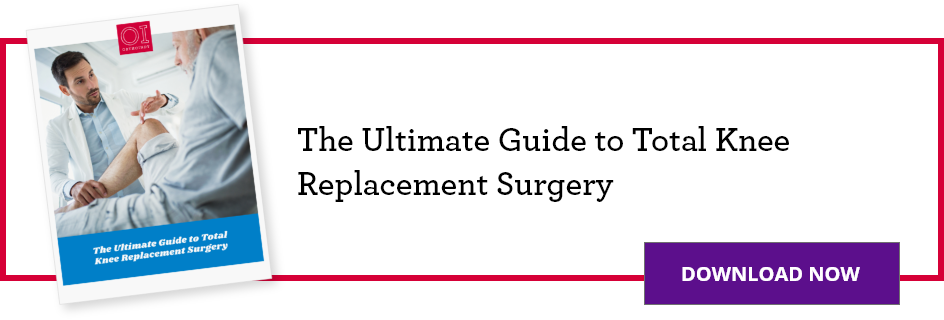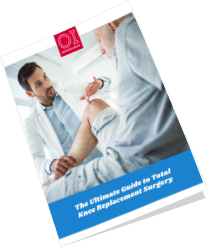THIS POST IS PART OF THE ULTIMATE GUIDE TO TOTAL KNEE REPLACEMENT
Brenda Hillman loves her garden, and bilateral knee replacement has given her the ability to continue working in it.
Brenda and her husband have covered their four acres of land with forty flowerbeds and are master gardeners. After a 30-year career as a staff nurse in labor and delivery— and a lot of gardening—Brenda’s knees began to feel some wear and tear. The pain she was feeling was caused by osteoarthritis.
Read on to learn how bilateral knee replacement helped Brenda overcome her arthritis knee pain and get back to her plants.
What is osteoarthritis of the knee?
Osteoarthritis of the knee is the breakdown of cartilage over time in your knee until no space is present between two bones. Eventually, the bones rub together, causing stiffness, pain and restricted range of motion.
Brenda has lived with the pain since 2013. It wasn’t unbearable, but it gradually got worse. Some knee arthritis symptoms she felt were stabbing pain when she walked, stiffness when she woke up and swelling that hindered her from doing the things she loved.
“(Osteoarthritis) never totally stopped me, but it limited my ability to do gardening,” Brenda says. “It slowed me down when working at the hospital. We like to travel and the knee pain and swelling limited our activities.”
When is it time to have a knee replacement?
After recommendations from friends in the medical field, Brenda came to OrthoIndy for a consultation with total joint specialist, Dr. Christopher Pomeroy. Dr. Pomeroy and his physician assistant, Jeannine Suarez, impressed Brenda throughout her experience.
They discussed options to treat her knee arthritis and get her back to the activities she enjoys. After evaluating Brenda’s condition, Dr. Pomeroy saw the clear symptoms of needing a knee replacement for both knees and decided on a simultaneous bilateral knee replacement. This surgery replaces both of the patient’s knees at the same time.

Simultaneous bilateral knee replacement
Brenda underwent a simultaneous bilateral knee replacement a year ago.
“Brenda had arthritis in all three compartments of both of her knees,” Dr. Pomeroy says. “She was not a good candidate for any kind of partial knee replacement. Therefore, we decided to proceed with full knee replacements on both of her knees (bilateral knee replacement).”
A total knee replacement surgery resurfaces the joint surfaces affected by the arthritis. All three of Brenda’s joints were affected in both knees. These joints include the top of the shin bone (tibia), the end of the thigh bone (femur) and the underside of the kneecap (patella).
A bilateral knee replacement was needed since osteoarthritis had worn down the cartilage on all of the joint surfaces.
There were four implants placed in each of Brenda’s knees for the replacement. A metal plate was placed on top of her shin bone, connecting to a metal cap on her thigh bone.
In between these two pieces a plastic piece acts as the cartilage and new cushion. The last piece is a plastic button put behind the kneecap to replicate the kneecap surface that rubs against the thigh bone (femur).
The bilateral knee replacement surgery is then complete, and therapy is the next important step in the knee replacement recovery process.
What is the recovery time for a bilateral knee replacement?
“Most people can return to work around eight weeks following a bilateral knee replacement,” Dr. Pomeroy says. “The motion of the knee needs to be obtained by participating in physical therapy by eight to nine weeks after surgery, so the knee replacement does not become stiff.”
Brenda’s knee surgery recovery has been successful. She remarks her worst days now are so much better than her best days were before her surgery.
She went through physical therapy, retired from nursing, resumed gardening in May with her husband and started traveling again only four months after her bilateral knee replacement.
What is the key to a successful recovery?
Brenda encourages anyone considering bilateral knee replacement surgery to consult with Dr. Pomeroy and Jeannine.
“Dr. Pomeroy and Jeannine are a great surgical team, but they cannot reach your best outcome without your hard work and determination in physical therapy,” Brenda said.
Brenda emphasizes that the first six weeks are crucial to meeting your goals after bilateral knee replacement. Being active in your recovery is key to successfully achieving your goals. Her and her husband are back to being master gardeners, and her scars have healed well since surgery.
“Everyone at OrthoIndy involved in my bilateral knee replacement was fantastic,” Brenda says. “The chaplain, registration people, the pre-op and post-op nurses, the anesthesiologist, the staff nurses on the floor, physical therapists, environmental services, etc. Everyone was happy and well-skilled in their areas of expertise. My OrthoIndy physical therapists in outpatient were phenomenal.”
Learn more about joint replacement surgery at OrthoIndy
Schedule an appointment
Your well-being is important to us. If you have knee pain and are considering knee replacement surgery, schedule an appointment with one of our orthopedic specialists to review your options.
If your injury or condition is recent, you can walk right into one of our OrthoIndy Urgent Care locations for immediate care. For rehabilitation and physical therapy, no referral is needed to see one of our physical therapists.

The Ultimate Guide to Knee Pain Relief
Take control of your knee pain, learn about treatment options, and find out if surgery might be able to help you get back to normal.





